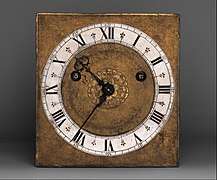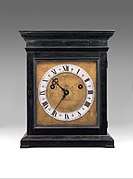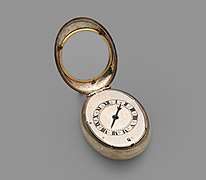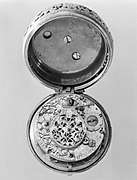Edward East (clockmaker)
Edward East (1602–1696) was watchmaker and clockmaker to Charles I of England. He was a notable horologist who succeeded David Ramsay.[1][2]
Biography
East was apprenticed in 1618 to Richard Rogers in the Goldsmiths' Company. He was one of the ten original assistants named in the charter of incorporation of the Clockmakers' Company, and at once took a leading part in its proceedings, and after serving in the subordinate capacities was elected master in 1645, a post he again occupied in 1652. He was the only treasurer ever appointed, and the creation of the office came about in a curious way. In 1647, the renter warden, Mr. Helden, refused to give the usual security for the stock of the company, and in this dilemma the office of treasurer was created, Mr. East and Mr. Hackett being nominated thereto, and the former chosen. On the death of Mr. East the office was allowed to lapse.
He at one time resided in Pall Mall, near the tennis court, and attended the king when tennis and other games were being played in the Mall, his Majesty often providing one of East's watches as a prize. Edward East seems to have removed to Fleet Street, for it is related that at a later period the king's attendant, Mr. Herbert, failing in the punctual discharge of his duties in the morning, his Majesty provided him with a gold alarum watch, which was fetched from the king's watchmaker, Mr. East, in Fleet Street. He was in Fleet Street in 1635, for a correspondent of Notes and Queries had in 1900 a MS. Return of Strangers within the ward of Farringdon Without wherein East is referred to as of Fleet Street, in the parish of St. Dunstan's in the West, and as the employer of one Elias Dupree, a Dutchman. The locality of a presumably still later residence is indicated by a reference to " Mr. East at the Sun, outside Temple Bar," in the London Gazette, 22–26 January 1690.
Edward East lived to a good age. There is no record of his death but his will was proved (its validity established) in February 1697.
Clocks and watches

A large silver alarum clock-watch by Edward East, which was kept at the bedside of Charles I, was presented by the king on his way to execution at Whitehall, on 30 January 1649, to Sir Thomas Herbert. Among the collections of Alfred Morrison was a warrant, dated 23 June 1649, from the Committee of Public Revenue to Thomas Fauconbridge, Esq., Receiver-General, authorizing him to pay "vnto Mr. Edward East, Watchmaker, the some of fortie pounds for a Watch and a Larum of gould by him made for the late King Charles by directions of the Earle of Pembrooke, by order of the Committee, and deliuered for the late King's use the xviith of January last."
In the Ashmolean Museum at Oxford is a watch by East with gold case in the form of a melon, studded all over with turquoises, the pendant being enamelled blue to match. Two other undoubted specimens of this master's work are in the Clockmakers' Museum. In the British Museum is a watch by East with a tortoiseshell case, dating from about 1640. The Victoria & Albert Museum also possesses a specimen of his work.[3] Mr. George Carr Glyn exhibited at the Guelph Exhibition a clock-watch by him in silver pierced cases. Among the Wetherfield collection were four long-case clocks and one bracket clock by East.
Gallery
- Clocks and watches by Edward East







References
- This article contains text from F. J. Britten (1904). Old clocks and watches & their makers. London: B. T. Batsford. which is now in the Public Domain.
- ↑ F. J. Britten (1904). Old clocks and watches & their makers. London: B. T. Batsford.
- ↑ "Table clock". British Museum. Retrieved 2012-01-17.
- ↑ "Victoria and Albert Museum, London". Collections.vam.ac.uk. Retrieved 2012-02-11.
| Wikimedia Commons has media related to Edward East (clockmaker). |